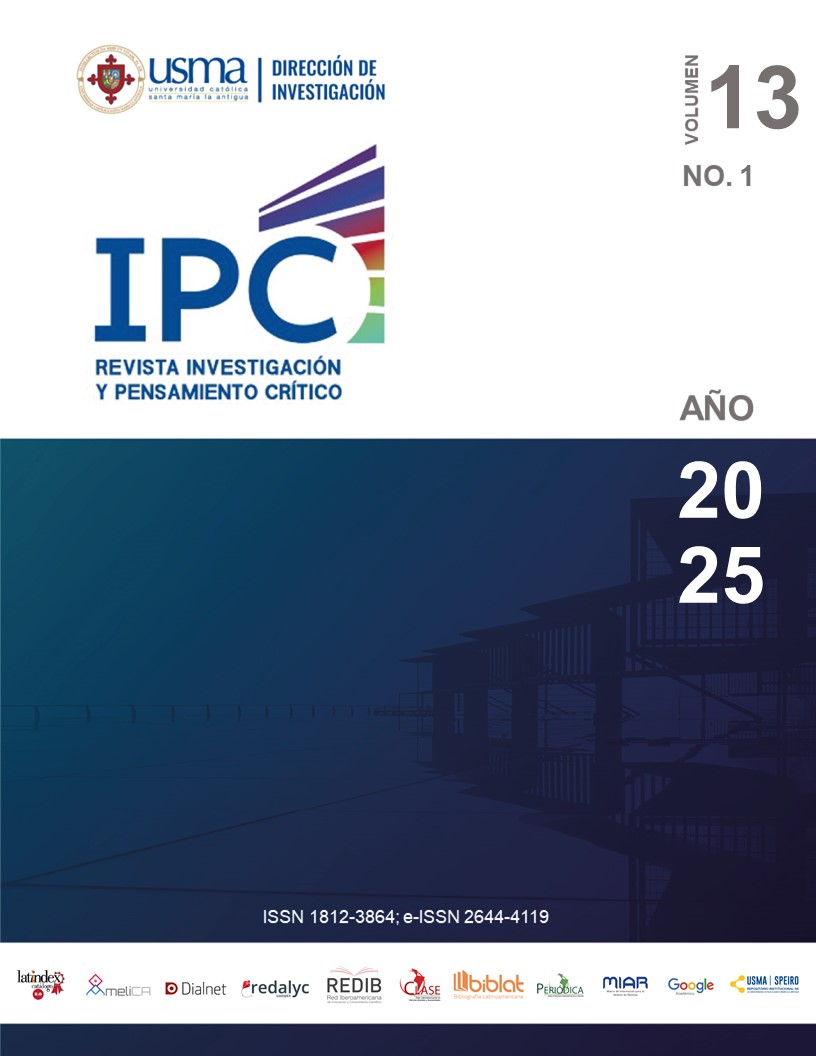Diagnosis of higher education at the Regional University Center of Colón: a gender approach
DOI:
https://doi.org/10.37387/ipc.v13i1.404Keywords:
gender approach, equal opportunities, management university, public policiesAbstract
In the 2030 Agenda Sustainable Development Goal Number 5 (SDG 5) aspires to: achieve equality as a fundamental human right and one of the essential foundations to build a peaceful, prosperous and sustainable world. In 2015, Panama adopted the SDGs. In 2016, it presented its Ist Report with strategic lines to advance the 2030 Agenda. In 2017 the Government presented a National Strategic Plan prioritizing actions to achieve the SDGs and in 2020 it presented the IInd Report. The Government Strategic Plans were used for the implementation and monitoring of the SDGs. The SDG Index (2020) placed the country in position 81 out of 166 countries, improving 9 positions compared to the previous year. In public university higher education institutions in Panama, there are a variety of mechanisms to align with the 2030 Agenda (implementation, monitoring and measurement). The UN proposed global indicators to guide monitoring and measurement, including SDG5. The effects of COVID-19 could have reversed the limited achievements that would have been made in terms of gender equality. UN-Women made a proposal to mitigate the impact and for long-term recovery; one of them: guarantee that data and coordination mechanisms include a gender perspective.
What mechanisms would the University of Panama be using to align with the SDG 2030 agenda and for the implementation, monitoring and measurement of these? What are the main gender inequalities present in the university context of the CRU of Colón? It is necessary to unfold the SDG5 indicators into periodic surveys and/or other data collection instruments (quantitative and qualitative) to measure progress and/or in university higher education. The norm provides access to opportunities, it does not give evidence of being discriminatory. However, the results seem to indicate that there is no substantive equality. There seems to be an individual effort for women to achieve their goals and not a change in the role of women in society and, in access, permanence, graduation from the teaching-administrative career and in university direction and management.
Downloads
References
Acuña Rodríguez, M. C (2014). Reflexiones en torno al vínculo género-educación superior. Costa Rica: Revista Educación 38(2), 89-106, e-ISSN: 22152644, julio-diciembre, 2014. http://dx.doi.org/10.15517/revedu.v38i2.15263
Centro Interuniversitario de Desarrollo (2016). Educación superior en Iberoamérica. Chile: (CINDA). https://cinda.cl/publicacion/educacion-superior-en-iberoamerica-informe-2016/
Centro Regional Universitario de Colón (1990-2022). Manuales de matrícula.
CEPAL (2010). ¿Qué estado para qué igualdad? XI Conferencia Regional sobre la Mujer de América Latina y El Caribe. Brasilia. https://repositorio.cepal.org/entities/publication/ea1f47ad-58f0-4331-8d33-7e7b9e8de489
CEPAL (2019). Planes de igualdad de género en América Latina y el Caribe. Mapas de ruta para el desarrollo. Observatorio de Igualdad de Género en América Latina y el Caribe. Estudios Nº 1 (LC/PUB.2017/1-P/Rev.1), Santiago, Chile. https://www.cepal.org/es/publicaciones/41014-planes-igualdad-genero-america-latina-caribe-mapas-ruta-desarrollo
Equal Measure 2030 (2022). Índice de género de los ODS. Volver a la normalidad no basta. https://www.equalmeasures2030.org.
Escobar, V. y Fruto de Santana, O. (2016). Educación superior en Iberoamérica. Informe Nacional Panamá. Chile: Centro Interuniversitario de Desarrollo (CINDA). https://cinda.cl/publicacion/educacion-superior-en-iberoamerica-informe-2016-informe-nacional-panama/
Montané, A. y Pessoa de Carvalho, M. E. (2012). Diálogo sobre género: justicia, equidad y políticas de igualdad en educación superior (Brasil y España). Revista Lusófona de Educação, 21, 97-120. https://www.redalyc.org/articulo.oa?id=34924585006
ONU (2019). Primer informe mundial sobre el desarrollo sostenible. El futuro es ahora: la ciencia al servicio del desarrollo sostenible. Grupo independiente de científicos designados por el Secretario General. https://sdgs.un.org/sites/default/files/2022-07/26929Spanish1918563_S_GlobalSusDevReport2019.pdf
ONU (2023). Informe de los objetivos de desarrollo sostenible. Departamento de Asuntos Económicos y Sociales. División de Estadística. https://unstats.un.org/sdgs/report/2023/The-Sustainable-Development-Goals-Report-2023_Spanish.pdf
República de Panamá (2017). I Informe voluntario de los ODS. Erradicar la pobreza y promover la prosperidad en un mundo cambiante. https://www.mides.gob.pa/wp-content/uploads/2017/09/Informe-Voluntario-ODS-2017.pdf
República de Panamá (2019). II Informe nacional voluntario de los ODS. Panamá: libre de pobreza y desigualdad, la sexta frontera. https://sustainabledevelopment.un.org/content/documents/26427Panama_Informe_Voluntario_Reducido_1_reduced.pdf
UNESCO (2018). Declaración de la III Conferencia Regional de Educación Superior (CRES) de América Latina y El Caribe. Instituto Internacional para la Educación Superior en América Latina y El Caribe (IESALC). https://unesdoc.unesco.org/ark:/48223/pf0000376753
UNESCO (2019). Declaración mundial sobre la educación superior en el siglo XXI: Visión y acción. Revista Educación Superior Y Sociedad (ESS), 9(2), 97-113. Recuperado a partir de https://www.iesalc.unesco.org/ess/index.php/ess3/article/view/171
Universidad de Panamá (2022). Estatuto Universitario. https://www.up.ac.pa/sites/default/files/Estatuto_color_2022.pdf
Universidad de Panamá (2018). Plan de desarrollo institucional 2017-2021. Dirección General de Planificación y Evaluación Universitaria. https://www.up.ac.pa/sites/default/files/transparencia/PD_Institucional_2017-2021_PM_FINAL.pdf
Universidad de Panamá (2022). Plan de desarrollo institucional 2022-2026. Dirección General de Planificación y Evaluación Universitaria. https://www.up.ac.pa/sites/default/files/2022-05/PDI%202022-2026%20aprobado%20por%20el%20CGU%20N%C2%B01-22%20del%2020-abril-22.pdf
Universidad de Panamá. Boletín estadístico (2010 – 2022). Dirección General de Planificación y Evaluación Universitaria. Departamento de Estadística. https://www.up.ac.pa/transparencia/boletinInformativo
Published
How to Cite
Issue
Section
License
Copyright (c) 2025 info:eu-repo/semantics/openAccess

This work is licensed under a Creative Commons Attribution-NonCommercial-ShareAlike 4.0 International License.
1. The authors preserves the patrimonial rights (copyright) of the published works, and favors and allows their reuse.
2. The journal (and its contents) use Creative Commons licenses, specifically the CC BY NC SA type, where: "the beneficiary of the license has the right to copy, distribute, display and represent the work and make derivative works provided you acknowledge and cite the work in the manner specified by the author or licensor."
3. They can be copied, used, disseminated, transmitted and exhibited publicly, provided that: i) the authorship and the original source of its publication (magazine, publisher and URL, DOI of the work) are cited; ii) are not used for commercial purposes.
4. Conditions of self-archiving. Authors are encouraged to electronically disseminate the post-print versions (version evaluated and accepted for publication), as it favors their circulation and dissemination, increases their citation and reach among the academic community.











